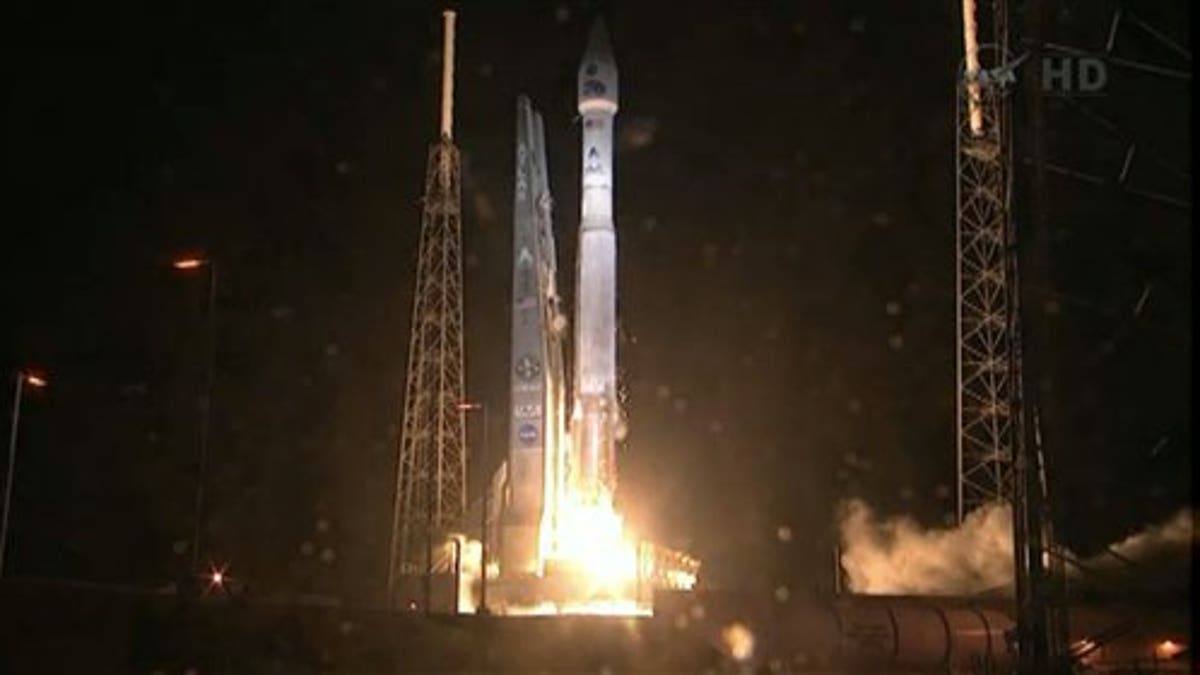
Aug. 30, 2012: This framegrab image provided by NASA-TV shows the Atlas V first stage and Centaur upper stage as it lifts off the launch pad at Cape Canaveral Air Force Station, Florida. (AP)
CAPE CANAVERAL, Florida – Twin satellites rocketed into orbit Thursday on a quest to explore Earth's treacherous radiation belts and protect the planet from solar outbursts.
NASA launched the science probes before dawn, sending them skyward aboard an unmanned rocket.
"They're now at home in the Van Allen belts where they belong," said Nicola Fox, deputy project scientist for the Johns Hopkins University Applied Physics Laboratory.
It's the first time two spacecraft are flying in tandem amid the punishing radiation belts of Earth, brimming with highly charged particles capable of wrecking satellites.
These new satellites -- shielded with thick aluminum -- are designed to withstand an onslaught of cosmic rays for the next two years.
"We're going to a place that other missions try to avoid and we need to live there for two years. That's one of our biggest challenges," said Richard Fitzgerald, project manager for Johns Hopkins.
[pullquote]
Fitzgerald wore a black tuxedo for the big event, "my good-luck tux." It's the same suit he wore for the launch of another set of twin science satellites that still are going strong after 10 years. "I'm hoping for the same" with these Radiation Belt Storm Probes, he said.
The Johns Hopkins Lab built the radiation belt probes for NASA, and is operating them from Maryland following a week of launch delays.
Scientists expect the $686 million mission to shed light on how the sun affects the Van Allen radiation belts, named after the astrophysicist who discovered them a half-century ago.
Earth's two doughnut-shaped radiation belts stretch thousands of miles into space; these inner and outer belts are full of high-energy particles from the sun and elsewhere in the cosmos, trapped by Earth's magnetic field.
Normally, the belts remain well above the International Space Station and low-flying satellites. But the belts can expand during solar storms right into the paths of orbiting spacecraft. If severe enough, the storms can cripple satellites and endanger astronauts, and disrupt power and communications on the ground.
The goal of this mission is to improve space weather forecasting.
"The Earth responds to what's coming from the sun, so we say, 'If the sun sneezes, the Earth catches a cold,' " said Nicola Fox, deputy project scientist for Johns Hopkins. The symptoms vary widely and need to be better understood, she said.
Science instruments aboard the nearly identical spacecraft will measure the high-energy particles coursing through the radiation belts and numbering in the trillions.
The satellites will traverse both the inner and outer belts, flying as close as 300 miles to Earth and as far away as almost 20,000 miles, and occasionally lapping one another. At times, the probes will be 100 miles apart, at other times 24,000 miles apart, or three of Earth's diameters.
Fox said the beauty of having two satellites is that scientists will see whether energy disturbances affect just one or both, allowing for measurements over space as well as time.
Earth is hardly alone in this curious setup.
Jupiter, Saturn, Uranus and Neptune also have magnetic fields and radiation belts. While the processes are understood, mysteries abound. Fox likens it to making a cake: "You know all the ingredients but you're not quite sure of the proportions of each piece in each given storm."
Compared with the simple Geiger counter on America's first satellite Explorer 1, which uncovered the radiation belts, these two new 1,400-pound probes contain the latest in microelectronics. Each satellite has eight science instruments.
"This is a phenomenal set of instruments," said University of Iowa physicist Craig Kletzing, a principal investigator. "This is the best that's ever been flown in the radiation belts, and we'll make tremendous advances."
The University of Iowa is where James Van Allen spent his famed career. His 1958 discovery of the radiation belts are said to be the first scientific discovery of the Space Age.
Sarah Van Allen, his daughter, was at the mission control center in Laurel, Md., for Thursday's launch.
For now, these newest satellites are called A and B. After a two-month checkout, NASA plans to give them real names.
Perhaps Van and Allen? That's what Fox calls them "because they're close to my heart."
Van Allen was 91 and dying when the Radiation Belt Storm Probes won approval in 2006. How would the late Van Allen feel about the endeavor?
"Very pumped up," Kletzing said.
It took NASA three tries to launch the spacecraft. Last week's attempts were thwarted by trouble with a tracking beacon on the Atlas V rocket and then stormy weather. NASA opted to wait until the passage of Hurricane Isaac before trying again.
